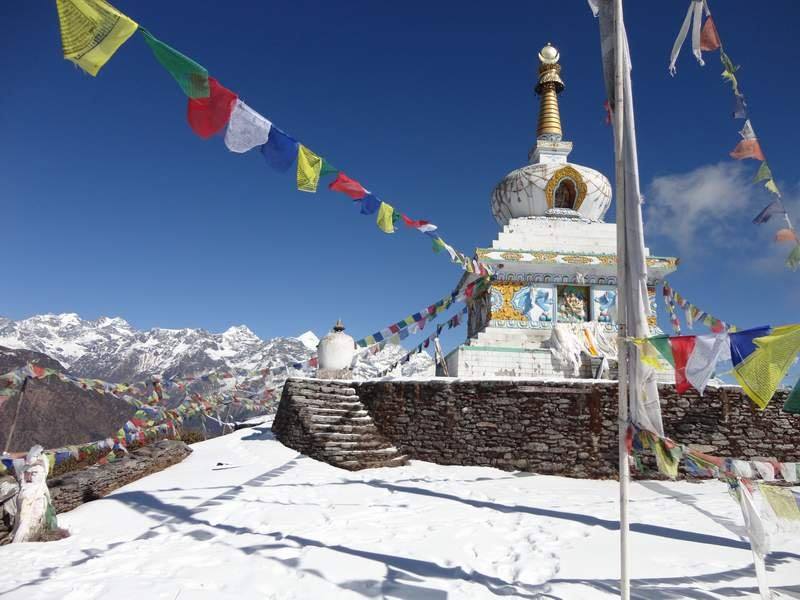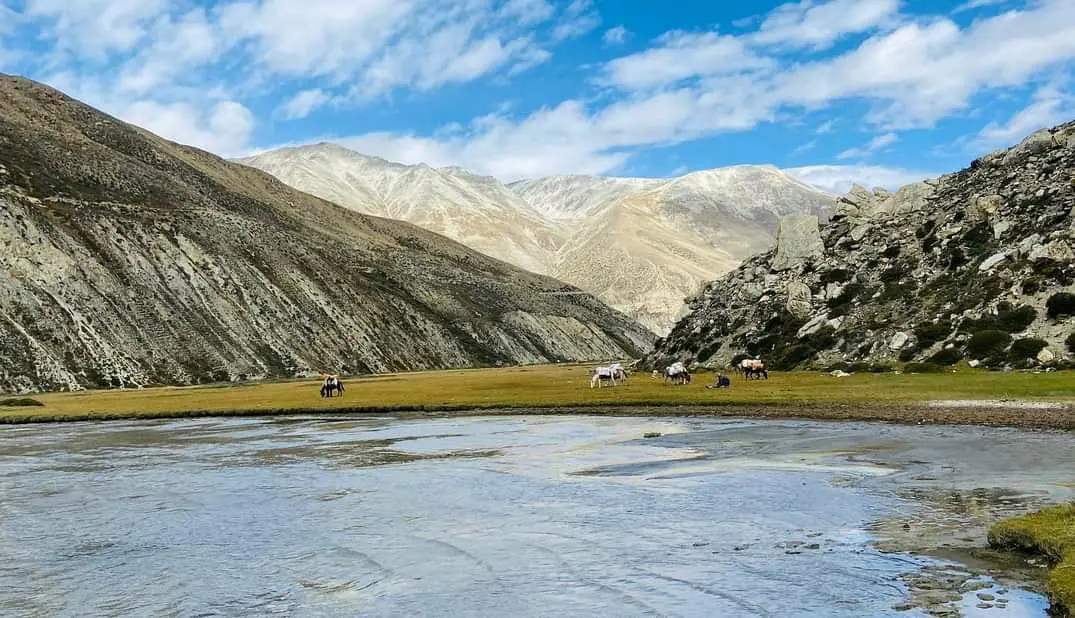Share this Article
INTRODUCTION
Ama Yangri, a sacred peak located in Nepal's Helambu region, holds immense cultural, spiritual, and environmental significance. Nestled within the Langtang National Park, Helambu is renowned for its rich Yolmo Buddhist heritage, breathtaking landscapes, and serene trekking trails. Revered as the guardian deity of this region, Ama Yangri is not just a towering mountain but also a focal point of religious devotion, local mythology, and ecological wonder. Additionally, it is a popular trekking destination, just 2 to 3 hours from Kathmandu, attracting both spiritual seekers and adventure enthusiasts.
The region's accessibility, combined with its profound spiritual significance, makes it a unique destination for trekkers. Those who journey to Ama Yangri are not just embarking on a physical adventure but are also partaking in a deeper spiritual quest. The mountain holds a special place in the hearts of the Yolmo people, and their connection to it runs deep, representing a perfect balance between spirituality and nature.
Trekking Experience: A Journey Through Spiritual Landscapes of Ama Yangri
The trek to Ama Yangri is a mesmerizing journey, starting from a bus ride to Tarke Gyang and then transitioning into a steady climb through enchanting forests and peaceful Yolmo villages. As trekkers ascend, the air becomes crisp, and vibrant prayer flags flutter in the wind, whispering blessings and mantras to those who pass. These flags, inscribed with sacred Tibetan symbols, not only mark the way but also carry prayers into the wind, seeking peace, prosperity, and spiritual upliftment for the people. As trekkers move further, they encounter the soothing tranquility of the forests and the gently terraced fields that add an almost otherworldly serenity to the landscape. The simple yet profound lifestyle of the Yolmo people (Tibetan-speaking buddhist community from Nepal's Helambu region) adds an element of cultural richness to the journey. The community's daily practices are interwoven with their reverence for the mountain, and trekkers often have the opportunity to share a meal or a story with the villagers along the way with each step, the world below seems to fade, replaced by a profound stillness that wraps around the sacred peak, offering both breathtaking beauty and a deep sense of serenity. The view above the clouds unveils a stunning panorama of the surrounding mountain range, making the journey even more awe-inspiring. The sight of the snow-capped peaks, including glimpses of Mount Everest in the distance, only deepens the sense of wonder and spiritual awe experienced by trekkers.
Historical and Mythological Significance
Ama Yangri, standing at approximately 3,771 meters, is deeply rooted in the spiritual traditions of the Yolmo people and Tibetan Buddhism. According to local mythology, the name "Ama Yangri" translates to "Divine Mother Yangri," representing the protective spirit that safeguards the Helambu Valley. This divine mother figure is revered for her ability to shield the valley from natural calamities and malevolent forces, keeping her people safe from harm.
Legends speak of her divine presence protecting the region during times of war, famine, and environmental disasters, solidifying her position as a symbol of both strength and compassion. Many believe that the mountain is a manifestation of the compassionate deity Tara, embodying both nurturing and protective aspects of the divine feminine. As the embodiment of Tara, Ama Yangri is seen as a spiritual guardian, offering solace and strength to the people who turn to her in times of need.
Over centuries, pilgrims and monks have traversed rugged paths to pay homage at Ama Yangri, seeking blessings for prosperity, protection, and enlightenment. The peak is also associated with Guru Padmasambhava, the revered 8th-century Buddhist master who is believed to have sanctified various Himalayan sites. His presence in the region adds a layer of mysticism, reinforcing the mountain's sacred status.
The oral traditions passed down through generations continue to preserve the mystique and sacredness of this revered mountain. These stories are passed from elders to the younger generation, ensuring that the cultural and spiritual essence of Ama Yangri is maintained. For the people of Helambu, the mountain is not merely a physical landmark but a manifestation of divine protection and spiritual grace.
Spiritual and Religious Significance
Ama Yangri is crucial in the spiritual life of the local community and Buddhist practitioners across the Himalayan region. It is often viewed as a natural stupa, an embodiment of pure spiritual energy. Every year, devotees embark on pilgrimages to the summit, performing prayer rituals and circumambulations in reverence of the deity. The act of circumambulating a sacred mountain or stupa is an important Buddhist practice, symbolizing the journey towards enlightenment and the purification of one’s mind.
One of the most significant religious events is the full-moon pilgrimage, during which monks, nuns, and lay devotees gather to chant prayers and perform ceremonial rituals. This event strengthens the spiritual connection between the Yolmo people and the wider Buddhist community. The chanting of sacred mantras and the ringing of bells at the mountain’s base create a harmonious atmosphere, inviting peace and positive energy into the world.
Meditation retreats in nearby caves and monasteries further emphasize Ama Yangri’s reputation as a place of spiritual awakening and inner transformation. These retreats offer a sanctuary for those seeking solitude and quiet reflection, allowing practitioners to immerse themselves in deep meditation. The stillness and natural beauty of the surroundings make it an ideal setting for spiritual rejuvenation.
The Intersection of Tradition and Modernity
Ama Yangri’s story mirrors broader tensions between tradition and modernity. While the sacred mountain has been integral to local spiritual life for centuries, modernization and globalization have introduced new dynamics. The influx of trekkers, photographers, and tourists has brought global attention to its significance, but the commercialization of spirituality risks reducing its profound essence to mere tourism.
Local stakeholders, including monasteries, conservationists, and community leaders, are engaging in discussions to protect Ama Yangri’s sanctity while embracing its potential as a cultural and eco-tourism hub. This balance is delicate, as the growth of the tourism industry threatens to undermine the authenticity of the spiritual experience. Community-led initiatives focusing on responsible tourism, waste management, and ethical trekking practices have been essential to preserving the mountain as a sacred site rather than a mere tourist attraction.
Efforts are being made to educate visitors on the spiritual and cultural importance of Ama Yangri, ensuring that they approach the site with respect and mindfulness. This includes promoting a deep understanding of the local customs, rituals, and the need to preserve the environment for future generations.
Environmental and Ecological Importance
Ama Yangri is not only a spiritual haven but also an ecological treasure, supporting diverse flora and fauna unique to the Himalayan biome. This region is home to rhododendron forests, rare medicinal plants, and elusive wildlife such as Red pandas and Himalayan monals. These species contribute to the region’s rich biodiversity, making it an area of significant ecological value.
The local flora, including medicinal herbs and plants used in traditional medicine, plays a vital role in sustaining the health and livelihood of the local population. Many villagers depend on these plants for food, medicine, and economic activities, making conservation efforts essential to their survival.
Climate change poses a significant threat to the region, with rising temperatures and unpredictable weather patterns impacting both biodiversity and the livelihoods of local communities. The melting of Himalayan glaciers and shifts in monsoon cycles further highlight the urgency of implementing conservation efforts to protect this revered landscape, protecting Ama Yangri’s environment is not only vital for the local people but also for global efforts to conserve the Himalayan ecosystem.
Constructing Authenticity: Cultural Narratives and Identity
The authenticity of Ama Yangri is shaped by the narratives crafted by locals, spiritual leaders, and conservationists. For centuries, these stories have reinforced the mountain’s role as a divine protector and spiritual refuge. These cultural expressions continue to shape the identity of the Yolmo people and the broader Himalayan community as the world becomes more interconnected, perceptions of Ama Yangri have evolved. Some view it as a sacred pilgrimage site, while others see it as a hidden gem for adventure tourism. The challenge lies in preserving the authenticity of these diverse interpretations without compromising the mountain’s spiritual and cultural values.
Modern-day pilgrims and trekkers, despite their different purposes, often find a shared sense of reverence for Ama Yangri, drawn not only by its spiritual significance but also by its untouched natural beauty. As global attention grows, so does the responsibility to ensure that Ama Yangri remains a place of peace, reflection, and spiritual renewal.
Conclusion
Ama Yangri is a beacon of spiritual heritage, natural beauty, and cultural resilience. Its significance extends beyond religious devotion, encompassing ecological stewardship and responsible tourism. As modernization and globalization continue to reshape Nepal’s sacred landscapes, the careful balance between tradition and progress will determine Ama Yangri’s future by fostering sustainable tourism, preserving oral histories, and promoting environmental awareness, local communities and global admirers can ensure that Ama Yangri remains a revered sanctuary for generations to come. The dynamic interplay between spirituality, ecology, and cultural heritage will continue to uphold its timeless role as the guardian of the Helambu Valley.
Categories:
Travel & Tourism
,
Adventure Activities
Tags:
Ama Yangri
,
Trekking








